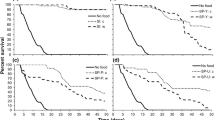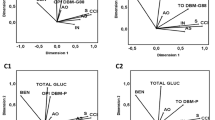Abstract
We determined the effectiveness of Ni as an elemental defence of Streptanthus polygaloides (Brassicaceae) against a crucifer specialist folivore, diamondback moth (DBM), Plutella xylostella. An oviposition experiment used arrays of S. polygaloides grown on Ni-amended (high-Ni) soil interspersed with plants grown on unamended (low-Ni) soil and eggs were allowed to hatch and larvae fed freely among plants in the arrays. We also explored oviposition preference by allowing moths to oviposit on foil sheets coated with high- or low-Ni plant extract. This was followed by an experiment using low-Ni plant extract to which varying amounts of Ni had been added and an experiment using sheets coated with sinigrin (allyl glucosinolate) as an oviposition stimulant. Diamondback moths laid 2.5-fold more eggs on low-Ni plants than on high-Ni plants and larval feeding was greater on low-Ni plants. High-Ni plants grew twice as tall, produced more leaves, and produced almost 3.5-fold more flowers. Low-Ni plants contained more allyl glucosinolate than high-Ni plants and moths preferred to oviposit on foil sheets dipped in low-Ni plant extract. Moths showed no preference when Ni concentration of low-Ni extract was varied and overwhelmingly preferred sinigrin coated sheets. We conclude that Ni hyperaccumulation is an effective elemental defence against this herbivore, increasing plant fitness through a combination of toxicity to DBM larvae and decreased oviposition by adults.
Similar content being viewed by others
References
Babaoglu M., Gezgin S., Topal A., Sade B. and Dural H. (2004) Gypsophila sphaerocephala Fenzl ex Tchihat.: A boron hyperaccumulator plant species that may phytoremediate soils with toxic B levels. Turkish Journal of Botany 28:273–278
Behmer S.T., Lloyd C.M., Raubenheimer D., Stewart-Clark J., Knight J., Leighton R.S., Harper F.A. and Smith J.A.C. (2005). Metal hyperaccumulation in plants: mechanisms of defence against insect herbivores. Functional Ecology 19:55–66
Berenbaum M.R. (1995). Turnabout is fair play: secondary roles for primary compounds. Journal of Chemical Ecology 21:925–940
Berenbaum M.R. and Neal J.J. (1985). Synergism between myristicin and xanthotoxin, a naturally cooccurring plant toxicant. Journal of Chemical Ecology 11:1349–1358
Bernays E.A. and Chapman R.F. (1987). Evolution of deterrent responses in phytophagous insects. In: Chapman R.F., Bernays E.A. and Stoffolano J.G. (eds), Perspectives in chemoreception and behavior. Springer-Verlag, New York, pp. 159–174
Boyd R.S. (1998). Hyperaccumulation as a plant defensive strategy. In: Brooks R.R. (eds), Plants that hyperaccumulate heavy metals. CAB International, Wallingford Oxon, pp. 181–201
Boyd R.S. (2004). Ecology of metal hyperaccumulation. New Phytologist 162:563–567
Boyd R.S. and Martens S.N. (1992). The raison d’être for metal hyperaccumulation in plants. In: Baker A.J.M., Proctor J. and Reeves R.D. (eds), The vegetation of ultramafic (serpentine) soils. Intercept, Andover, pp. 279–289
Boyd R.S. and Martens S.N. (1994). Nickel hyperaccumulated by Thlaspi montanum var.montanum is acutely toxic to an insect herbivore. Oikos 70:21–25
Boyd R.S. and Moar W.J. (1999). The defensive function of Ni in plants: response of the polyphagous herbivore Spodoptera exigua (Lepidoptera: Noctuidae) to hyperaccumulator and accumulator species of Streptanthus (Brassicaceae). Oecologia 118:218–224
Brooks R.R., Lee J., Reeves R.D. and Jaffré T. (1977). Detection of nickeliferous rocks by analysis of herbarium specimens of indicator plants. Journal of Geochemical Exploration 7:49–57
Davis M.A. and Boyd R.S. (2000). Dynamics of Ni-based defense and organic defences in the Ni-hyperaccumulator, Streptanthus polygaloides (Brassicaceae). New Phytologist 146:211–217
Dethier V.G. (1954). Evolution of feeding preferences in phytophagous insects. Evolution 8:33–54
Dyer L.A., Dodson C.D., Stireman J.O., Tobler M.A., Smilanich A.M., Fincher R.M. and Letourneau D.K. (2003). Synergistic effects of three piper amides on generalist and specialist herbivores. Journal of Chemical Ecology 29:2499–2514
Ehrlich P.R. and Raven P.H. (1964). Butterflies and plants: a study in coevolution. Evolution 18:586–608
Erickson J.M. and Feeny P. (1974). Sinigrin: a chemical barrier to the black swallowtail butterfly, Papilio polyxenes. Ecology 55:103–111
Ernst W.H.O. (1990). Ecological aspects of sulfur metabolism. In: Rennenberg H., Brunold C., De Kok L.J. and Stulen I. (eds), Sulfur nutrition and sulfur assimilation in higher plants. SPB Academic Publishing, The Hague, pp. 131–144
Feeny P. (1977). Defensive ecology of the cruciferae. Annals of the Missouri Botanical Garden. 64:221–234
Fraenkel G. (1959). The raison d’être of secondary plant substances. Science 121:1466–1470
Futuyma D.J. (1983). Evolutionary interactions among herbivorous insects and plants. In: Futuyma D.J. and Slatkin M. (eds), Coevolution. Sinauer Associates Inc., Sunderland, pp. 207–231
Gatehouse J.A. (2002). Plant resistance towards insect herbivores: a dynamic interaction. New Phytologist 156:145–169
Gould S.J. and Verba E.S. (1982). Exaptation—a missing term in the science of form. Paleobiology 8:4–15
Hanson B., Lindblom S.D., Loeffler M.L. and Pilon-Smits E.A.H. (2004). Selenium protects plants from phloem-feeding aphids due to both deterrence and toxicity. New Phytologist 162:655–662
Harborne J.B. (1993). Introduction to ecological biochemistry. Academic Press, London
Harvey C.T. 2002. The effects of habitat complexity on biological control of herbivores and natural enemy interactions. M.S. Thesis, Auburn University
Hay M.E., Kappel Q.E. and Fenical W. (1994). Synergisms in plant defenses against herbivores: interactions of chemistry, calcification, and plant quality. Ecology 75:1714–1726
Hopkin S.P. (1989). Ecophysiology of metals in terrestrial invertebrates. Elsevier Science, New York
Huang X. and Renwick J.A.A. (1994). Relative activities of glucosinolates as oviposition stimulants for Pieris rapae and P. napi oleracea. Journal of Chemical Ecology 20:1025–1037
Huitson S.B. and Macnair M.R. (2003). Does zinc protect the zinc hyperaccumulator Arabidopsis halleri from herbivory by snails?. New Phytologist 159:453–460
Janzen D.H. (1980). When is it coevolution?. Evolution 34:611–612
Jiang R.F., Ma D.Y., Zhao F.J. and McGrath S.P. 2005. Cadmium hyperaccumulation protects Thlaspi caerulescens from leaf feeding damage by thrips (Frankliniella occidentalis). New Phytol. (in press)
Jensen S., Broadley M.R., Robbrecht E. and Smets E. (2002). Aluminum hyperaccumulation in angiosperms: A review of its phylogenetic significance. Botanical Review 68:235–269
Jhee E.M., Dandridge K.L., Christy A.M. and Pollard A.J. (1999). Selective herbivory on low-zinc phenotypes of the hyperaccumulator Thlaspi caerulescens (Brassicaceae). Chemoecology 9:93–95
Justus K.A., Dosdall L.M. and Mitchell B.K. (2000). Oviposition by Plutella xylostella (Lepidoptera: Plutellidae) and effects of phylloplane waxiness. Journal of Economic Entomology 93:1152–1159
Justus K.A. and Mitchell B.K. (1996). Oviposition site selection by the diamondback moth, Plutella xylostella (L.) (Lepidoptera: Plutellidae). Journal of Insect Behavior 9:887–898
Kruckeberg A.R. (1984). California serpentines: flora, vegetation, geology, soils and management problems. University of California Press, Berkeley
Levin D.A. (1976). The chemical defenses of plants to pathogens and herbivores. Annual Review of Ecology and Systematics 7:121–159
Louda S. and Mole S. (1991). Glucosinolates: chemistry and ecology. In: Rosenthal G.A. and Berenbaum M.R. (eds) Herbivores: their interactions with secondary plant metabolites. Academic Press, San Diego, pp. 123–164
Macnair M.R. (2003). The hyperaccumulation of metals by plants. Advances in Botanical Research 40:63–105
Martens S.N. and Boyd R.S. (1994). The ecological significance of nickel hyperaccumulation: a plant chemical defense. Oecologia 98:379–384
Mauricio R. and Rausher M.D. (1997). Experimental manipulation of putative selective agents provides evidence for the role of natural enemies in the evolution of plant defense. Evolution 51:1435–1444
McNaughton S.J. and Tarrants J.L. (1983). Grass leaf silicification: natural selection for an inducible defense against herbivores. Proceedings of the National Academy of Sciences of the United States of America 80:790–791
Noret N., Meerts P., Tolrà R., Poschenrieder C., Barceló J. and Escarre J. (2005). Palatability of Thlaspi caerulescens for snails: influence of zinc and glucosinolates. New Phytologist 165:763–772
Pollard A.J. (2000). Metal hyperaccumulation: a model system for coevolutionary studies. New Phytologist 146:179–181
Pollard A.J. and Baker A.J.M. (1997). Deterrence of herbivory by zinc hyperaccumulation in Thlaspi caerulescens (Brassicaceae). New Phytologist 135:655–658
Raffauf R.F. (1996). Plant alkaloids: a guide to their discovery and distribution. Food Products Press, New York
Rausher M.D. (1992). Natural selection and the evolution of plant-animal interactions. In: Roitberg B.D. and Isman M.S. (eds), Insect chemical ecology: an evolutionary approach. Chapman and Hall, New York, pp. 20–88
Reeves R.D., Brooks R.R. and Macfarlane R.M. (1981). Nickel uptake by Californian Streptanthus and Caulanthus with particular reference to the hyperaccumulator S. polygaloides Gray (Brassicaceae). American Journal of Botany 68:708–712
Reeves R.D. (2003). Tropical hyperaccumulators of metals and their potential for phytoextraction. Plant and Soil 249:57–65
Reeves R.D. and Baker A.J.M. (2000). Metal-accumulating plants. In: Raskin I. and Ensley B.D. (eds), Phytoremediation of toxic metals. John Wiley, New York, pp. 193–229
Rosenthal G.A. and Janzen D.H. (1979). Herbivores: their interactions with secondary plant metabolites. Academic Press, New York
SAS Institute. 2005. JMP IN 5.1. Thomson – Brooks/Cole, Belmont
Scott I.M., Puniani E., Durst T., Phelps D., Assabgul R.A., Sanchez-Vindas P., Poveda L., Philogene B.J.R. and Arnason J.T. (2002). Insecticidal activity of Piper tuberculatum Jacq. extracts: synergistic interaction of piper amides. Agricultural and Forest Entomology 4:137–144
Seigler D.S. (1998). Plant secondary metabolism. Kluwer, Dordrecht
Shapiro A.M. (1981a). Egg-mimics of Streptanthus (Cruciferae) deter oviposition by Pieris sisymbrii (Lepidoptera: Pieridae). Oecologia 48:142–143
Shapiro A.M. (1981b). The pierid red-egg syndrome. American Naturalist 117:276–294
Shapiro A.M. (1981c). The pierid fauna of jewel flower at a mid-elevation Sierran locality. Journal of the Lepidopterists’ Society 35:322–324
Singer M.C. (1986). The definition and measurement of oviposition preference in plant-feeding insects. In: Miller J. and Miller T.A. (eds), Plant-insect interactions. Springer-Verlag, Berlin, pp. 65–94
Talekar N.S. and Shelton A.M. (1993). Biology, ecology, and management of the diamondback moth. Annual Review of Entomology 38:275–301
Tolrà R.O., Poschenrieder C., Alonso R., Barceló D. and Barceló J. (2001). Influence of zinc hyperaccumulation on glucosinolates in Thlaspi caerulescens. New Phytologist 151:621–626
Twigg L.E. and King D.R. (1991). The impact of fluoroacetate-bearing vegetation on native Australian fauna: a review. Oikos 61:412–430
Wall M.A. and Boyd R.S. (2002). Nickel accumulation in serpentine arthropods from the Red Hills, California. Pan-Pacific Entomologist 78:168–176
Walling L.L. (2000). The myriad plant responses to herbivores. Journal of Plant Growth Regulation 19:195–216
Whittaker R.H. and Feeny P.P. (1971). Allelochemicals: Chemical interactions between species. Science 171:757–770
Zar J.H. (1996). Biostatistical analysis. Prentice-Hall, Englewood Cliffs
Acknowledgements
The authors wish to thank Dr. John Odom for assistance with ICP analysis and Bill Wills for assisting with carbon and nitrogen analysis. Glucosinolate analysis was performed by POS Pilot Plant Corporation of Saskatoon, Canada. The authors express gratitude to Dr. Debbie Folkerts, Dr. Mark MacKenzie and two anonymous reviewers for critically reviewing this manuscript.
Author information
Authors and Affiliations
Corresponding author
Rights and permissions
About this article
Cite this article
Jhee, E., Boyd, R., Eubanks, M. et al. Nickel hyperaccumulation by Streptanthus polygaloides protects against the folivore Plutella xylostella (Lepidoptera: Plutellidae). Plant Ecol 183, 91–104 (2006). https://doi.org/10.1007/s11258-005-9009-z
Received:
Accepted:
Published:
Issue Date:
DOI: https://doi.org/10.1007/s11258-005-9009-z




